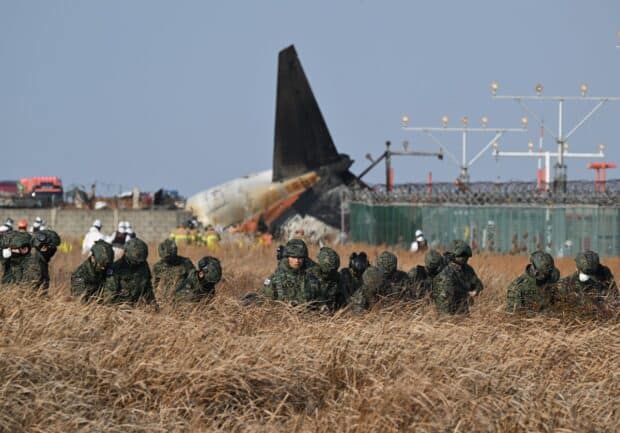What we know about Jeju Air plane crash in South Korea

SEOUL — A Jeju Air plane flying from Bangkok to South Korea with 181 people on board crashed on landing Sunday, leaving all but two people plucked from the wreckage feared dead.
Here’s what we know so far.
What happened?
A Boeing 737-800 aircraft belonging to low-cost carrier Jeju Air, flying from Bangkok to Muan airport, was warned of a bird strike by the control tower, officials said, during its first attempt at landing shortly after 9:00 am (midnight GMT).
READ: All but 2 feared dead after South Korea plane crashes with 181 aboard
Minutes later, with the pilot issuing a “mayday” warning, it tried to land again, with video showing it attempting a “belly landing” without its landing gear activated.
Article continues after this advertisement
Dramatic video shows the plane skidding along the runway with smoke trailing out, until it hits a wall at the end and bursts into flames.
Article continues after this advertisement
What caused the accident?
Investigations have been launched, but officials suspect the accident could have been caused by bird strike and adverse weather conditions.
When asked if the accident happened due to the runway being too short — video shows the plane coming off the tarmac and hitting a wall — one official said this was likely not a factor.
“The runway is 2,800 meters long, and similar-sized aircraft have been operating on it without issues,” they said.
What is a bird strike and how harmful is it?
A bird strike is a collision between a bird and an aircraft in flight.
READ: Bird strike, adverse weather likely caused fatal S. Korea plane crash
A bird strike can be hazardous to aircraft safety and jets are especially vulnerable to loss of power if birds are sucked into the air intakes, according to the UN agency International Civil Aviation Organization (ICAO). A number of fatal accidents have occurred globally due to bird strikes.
But in 2009, a US Airways Airbus A320 famously ditched in New York’s Hudson River after a bird strike on both of its engines, in an incident widely known as the “Miracle on the Hudson” because there was no loss of life.
Where was the plane coming from?
The plane was flying from Bangkok, Thailand to South Korea’s Muan county, about 288 kilometres (180 miles) southwest of the national capital Seoul.
Passengers on board, survivors
There were a total of 175 passengers and six crew members onboard. Rescue workers plucked out two survivors — both flight attendants — from the wreckage. As of mid-afternoon, 124 people have been confirmed dead.
READ: Passengers on crashed plane were 173 S. Koreans, 2 Thais
Officials said there was “little chance of survival,” for others, adding that the plane was “almost completely destroyed,” during the crash.
Rescue operation
Hundreds of firefighters and other emergency responders — including military — were deployed to the area, with the country’s acting president designating the site a special disaster zone.
Authorities said families were waiting at the first floor of the Muan airport. Many were seen crying in despair as they heard the news.
Aviation safety record
South Korea’s aviation industry has a solid safety record and the crash was the first fatal accident for Jeju Air.
READ: Jeju Air ‘sincerely apologizes’ after fatal S. Korea plane crash
A Jeju Air-operated Bombardier Q400 carrying 74 passengers veered off the runway due to strong winds at another southern airport, Busan-Gimhae on August 12, 2007. A dozen people were injured.
Government response
The accident occurred with South Korea in the throes of a political crisis, with its third president in a month. Acting President Choi Sang-mok, on his third day in office, convened an emergency meeting with cabinet members to discuss the rescue operation and response and visited the crash scene.